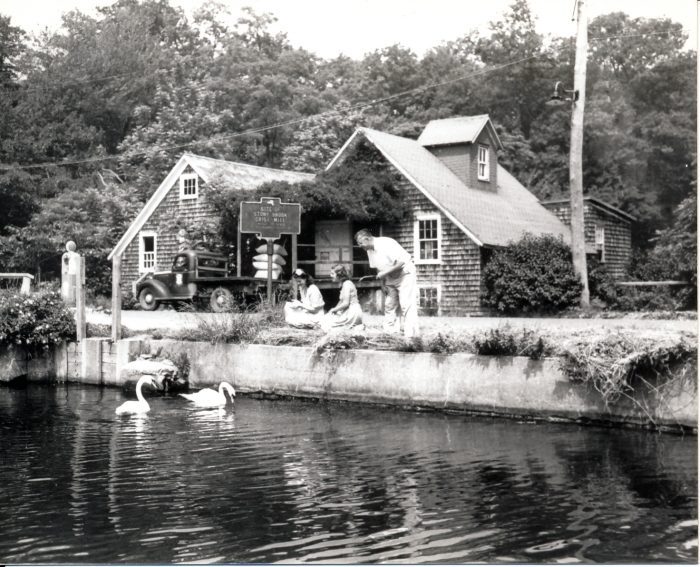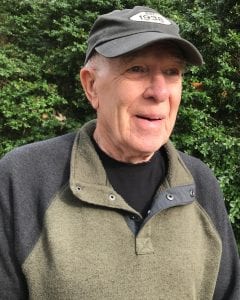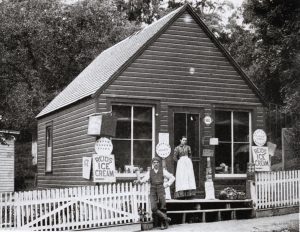History Close at Hand: Stony Brook before and after Ward Melville

By Beverly C. Tyler
“Don’t change Stony Brook too much! Leave some dirt roads, some crooked lanes, some old trees, some old homes and the winding brook and creeks. Clean them up a bit, if you will. Restore for permanency, but don’t use 20th-century plastic surgery on a 17th-century face.” — Edward A. Lapham, “Stony Brook Secrets”

Frank Melville, Ward’s father, was intrigued with Williamsburg and wanted to do something here. After Frank Melville died, Ward carried out the project and said in January 1940, “This project has been in my mind and in the minds of my mother and father before me going back some 10 years.”
Ward Melville envisioned the rehabilitated Stony Brook as a beautification project, an economic engine and a community social undertaking. As described in a pamphlet, “An interesting and most pleasant consequence of the Stony Brook project was the new interest the villagers took in the appearance of their own homes as the village green and shopping center took shape. … As pride of appearance asserted itself, the whole village began to acquire its present neat, clean-cut look of simplicity.”
Melville saw Stony Brook as a community where people would walk, greet one another, converse, discuss the day’s politics and be responsible, involved citizens. The village green and central post office were the keys to this concept. However, the inclusion of village shops and offices for doctors, dentists and real estate agents was designed to make this a functioning community.
Main Street in Stony Brook during the 19th and early part of the 20th century was an active commercial area with a wide variety of shops. This commercial and tourist-generated activity ended with World War I as Stony Brook became a small, locally used harbor village.
South of Harbor Road and the mill pond, there were several small homesteads and farms, a harness maker’s shop, a blacksmith shop and a schoolhouse. The business area began at the grist mill, and except for Jacinsky’s Saloon and a bakery opposite Harbor Road, all the stores were on the west side of the road between the mill pond and the harbor.
Shops included an ice cream parlor, drug store, hardware store, tea room, secondhand clothing store, Chinese laundry, a tailor shop, a harness maker’s shop that became a butcher shop and grocery store about 1900, a barber shop, livery stable, shoemaker’s shop, post office and at least two general stores.
The butcher in Stony Brook at the turn of the 20th century was Orlando G. Smith. His brother, Charles E. Smith, ran a butcher shop and general store in East Setauket. Orlando took over the butcher business from Bennie Wells, who died in 1875. In 1898, Orlando built a new store on the site of an earlier butcher shop run by George Hawkins.
In his booklet “A Century of Progress,” Percy Smith indicated, “In the mid-[1890s], farmers around Stony Brook began decreasing the sale of their livestock, and Orlando Smith was forced to find another source of supply. The closest place was Bridgeport, about 15 miles across the Sound, but Smith encountered many difficulties obtaining meat from even so short a distance.
“His order had to go to Bridgeport by mail. The meat was then hauled to the Bridgeport docks and shipped by boat to Port Jefferson. There, it was loaded into a wagon and brought to Stony Brook. During this time, Orlando bought what meat he could, but this had dwindled mostly to calves, lambs and pigs.”
Orlando Smith’s butcher shop was located south of the current Reboli Center. In 1913, Percy Smith took over the butcher business after it had been owned for less than a year by Captain Robert F. Wells and then by Percy’s father, W.H. Smith. In 1922, Percy moved to a new location in the old post office building located a few lots north of the Reboli Center.

Up Christian Avenue and just to the left, behind the house on the corner of Sand Street, was Tom and Mamie Anderson’s store. According to Edward A. Lapham’s “Stony Brook Secrets,” it had been a general store until World War I, when “groceries became so difficult to obtain that Tom gave up that end of the business and sold only ice cream and candy. He also sold real estate and looked after the town roads.”
When they first came to Stony Brook in the 1920s, Lapham and his wife Anna took a room at the Andersons’ home. Lapham noted that Mrs. Anderson “explained that her home was old fashioned, that there was no running water and that the outhouse was located on the hill above the store. However, if we wanted the room, she would try to make us comfortable.”
Many residents in Stony Brook would provide a room for visitors, especially during the summer when the Stony Brook Assembly was in operation.
Returning to the center of the business area of Stony Brook, the Bank of Suffolk County began its operation in 1907 in a building at the south corner of the old business triangle, which is now part of the Stony Brook Village Green. The building, featuring a shingled mansard roof, was owned by the Odd Fellows and contained a drug store and soda fountain, a library, lodge and dance hall in addition to the bank. The bank moved to the current Reboli Center in 1912, and the original building was torn down as part of the rehabilitation of the Stony Brook shopping area in 1941.
When the bank moved, it occupied a location formerly owned by Dan Sherry, who ran a livery stable before the turn of the century. Just north of Sherry’s was the home and general store of J.N. Gould. Gould’s house later became the home of Doctor Squire. North of Gould’s home was the general store and home of Edward Oaks. Oaks, in 1873, was a “dealer in dry goods, groceries and other supplies.”
According to Percy Smith, Oaks’ general store — later Toppings general store — was the “better” general store in town. “It had everything,” Smith commented, “Bales of hay, kerosene, hardware, patent medicine, food and clothing.”
When the rehabilitation of Stony Brook was completed, Percy Smith was the first shopkeeper to move into the new shopping center. Percy opened his butcher shop in what is now Wiggs Opticians. Many old stores and homes were moved and restored, while many others were demolished. The result was a modern Stony Brook business area with a strong flavor of the past.
An “Images of America” book on the history of Stony Brook is available from the Three Village Historical Society. For further information, contact the Society at 631-751-3730 or stop at the Society History Center and book/gift shop, 93 North Country Road, Setauket, Thursdays through Sundays from 12-4 p.m.
A copy of “Stony Brook Secrets” is available in the Long Island collection of the Emma S. Clark Memorial Library.
Beverly C. Tyler is a Three Village Historical Society historian and author of books available from the society.






